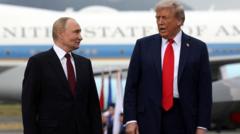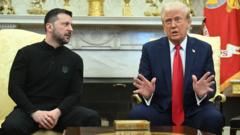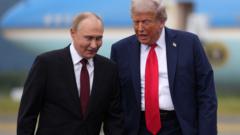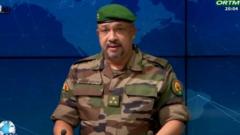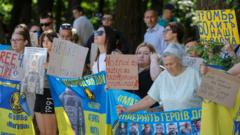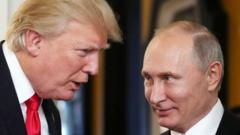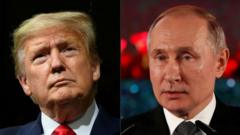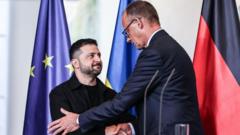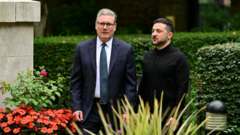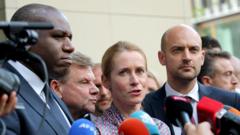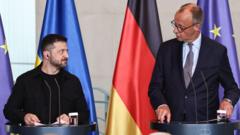#### The failure to broker a ceasefire agreement puts pressure on both leaders and leaves Ukraine in an uncertain situation following the summit.
### No Agreement in Sight: Trump-Putin Summit Leaves Ukraine in Limbo
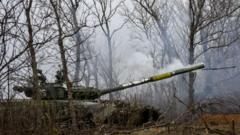
### No Agreement in Sight: Trump-Putin Summit Leaves Ukraine in Limbo
#### A tense summit between Trump and Putin in Alaska ends without a ceasefire for Ukraine, impacting international perceptions and potential actions.
In a significant diplomatic encounter, U.S. President Donald Trump and Russian President Vladimir Putin concluded their much-anticipated summit in Alaska without reaching any consensus regarding a ceasefire in Ukraine. The nearly three-hour meeting, which many had hoped would pave the way for relief in the ongoing conflict, ended with a vague joint statement and no direct engagement with pressing questions from the media.
Upon reflection, Trump acknowledged, "There's no deal until there's a deal," effectively conceding to the reality that after extensive discussions, concrete agreements remain absent. While he suggested that some progress was made, the specifics were dishearteningly vague and left open to interpretation.
The unprecedented summit was intended to showcase Trump’s diplomatic prowess, yet the lack of tangible outcomes could significantly dent his reputation as a dealmaker, especially in the eyes of global allies and at home. With no ceasefire achieved and no upcoming talks involving Ukrainian President Volodymyr Zelensky proposed, concerns linger regarding Russia's ongoing military activities.
Amidst the pomp of the summit, it was evident that nuances were at play. For instance, Putin seemed at ease addressing the audience, while Trump appeared in a supporting role. This dynamic, coupled with Trump's earlier assertions of "severe consequences" for Russia's actions, raises questions about the efficacy of his future diplomatic strategies. Observers are left to ponder whether Trump will indeed follow through on the threats of sanctions he previously articulated.
Ukrainians, while relieved that no detrimental agreements were made, remain on edge. Past experiences have fostered skepticism toward any deal involving Russia, with concerns that the absence of a ceasefire may invite further aggression. Putin's references to the "root causes" of the Ukraine conflict hinted at his continuing ambitions to reshape Ukraine’s sovereignty, which adds to the anxiety that the summit did little to mitigate ongoing violence or foster peace.
As the dust settles from this political theater, two pressing questions emerge: Will Trump impose the promised sanctions against Russia, and what will be the next steps in Ukraine's fight for autonomy amid increasing uncertainties? The outcome of this summit poses a critical juncture not only for U.S.-Russian relations but also for the future of peace in Ukraine.
Upon reflection, Trump acknowledged, "There's no deal until there's a deal," effectively conceding to the reality that after extensive discussions, concrete agreements remain absent. While he suggested that some progress was made, the specifics were dishearteningly vague and left open to interpretation.
The unprecedented summit was intended to showcase Trump’s diplomatic prowess, yet the lack of tangible outcomes could significantly dent his reputation as a dealmaker, especially in the eyes of global allies and at home. With no ceasefire achieved and no upcoming talks involving Ukrainian President Volodymyr Zelensky proposed, concerns linger regarding Russia's ongoing military activities.
Amidst the pomp of the summit, it was evident that nuances were at play. For instance, Putin seemed at ease addressing the audience, while Trump appeared in a supporting role. This dynamic, coupled with Trump's earlier assertions of "severe consequences" for Russia's actions, raises questions about the efficacy of his future diplomatic strategies. Observers are left to ponder whether Trump will indeed follow through on the threats of sanctions he previously articulated.
Ukrainians, while relieved that no detrimental agreements were made, remain on edge. Past experiences have fostered skepticism toward any deal involving Russia, with concerns that the absence of a ceasefire may invite further aggression. Putin's references to the "root causes" of the Ukraine conflict hinted at his continuing ambitions to reshape Ukraine’s sovereignty, which adds to the anxiety that the summit did little to mitigate ongoing violence or foster peace.
As the dust settles from this political theater, two pressing questions emerge: Will Trump impose the promised sanctions against Russia, and what will be the next steps in Ukraine's fight for autonomy amid increasing uncertainties? The outcome of this summit poses a critical juncture not only for U.S.-Russian relations but also for the future of peace in Ukraine.


